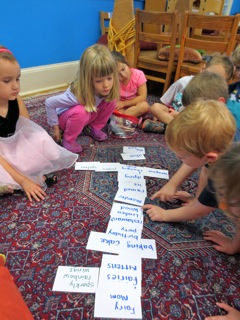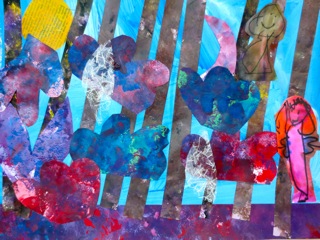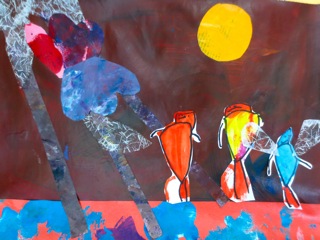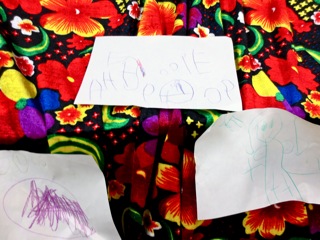Ways to document a dramatic play arc
"Finishing up Little Wolf's Book of Badness today - the story mountain is in a plateau so it's rough going," one of the co-oping parents recorded in the class journal on 21 May 2013. Story time and dramatic play can be shaped using all the tools that authors themselves use. Reviewing the elements and literary devices of a story is kind of like a professional writers' workshop. Each play session is a condensed form of hammering out characters and plot.
There are many different ways to map out the stories we share with children. Using the image of the story mountain helps children visualize and understand how a story builds the plot towards conflict and then through to resolution.
That said, I find that referring to a story mountain is especially helpful in grappling with the pacing of a book. It shapes an awareness of story. I don't use a graphic representation, preferring to simply talk about it while using my hand to show the plateau and rise. The author has built in the ebb and flow of exposition and action and this helps us prepare for the pace of the story. Once introduced, a teacher can use it to settle children during story time and young children learn to employ these same devices into their dramatic play descriptions.
This post shares some of the ways I use different methods of documenting dramatic play and how the children adopt the practice of documentation for their own use. They share a language that both reveals an understanding of story through literary device and this documentation enriches their dramatic play arcs.
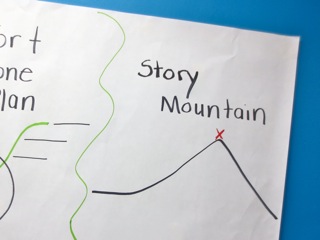
In the first photograph above, we are using story cards to map out a dramatic play arc. Each card has a character, a place, or an action/event that is part of their dramatic play. The children have named this arc "Linden Wood. Without an 's' one of them tells me...just wood." They are able to and are encouraged to add details to the story before and after each dramatic play session. During the iteration pictured here, they added a "sparkly rainbow wings" card next to the "fairies" card. They also asked to remove the cards, "alive again" and "the end" because they told me that including them means that the story would be over.
[gallery columns="2" ids="3423,3422,3421,3415"]
We have used these story cards for several weeks. Depending on who is playing some cards may not be used. For instance, in one version of Linden Wood, there are kittens in another there are not. Last week, the human fairies did not need their rainbow sparkly wings so they asked for the card to be removed. In another version of the story there is a Mama and Baby t-rex super heroes. They have a card that also reads "weapons". A weaponized Mama and Baby t-rex. It is a situation. There is also a changing roster of "troublemakers" which have only increased in number after reading different books during story time.
Last week I introduced a new way to organize this information to the children. We used a spoke chart, aka a learning web to organize the information. This first version is simply a draft and it was rough going at first. I could see that the children had really gotten used to the story cards and this made the effort all that more important. Shaking things up like this reactivated their thinking about story elements. I have set up the story cards in a self-limiting way because they are written and edited in the moment. Only one card is truly set apart and that is the one for Linden Wood. It has a box frame that I drew around the words. Ideally, each would be color-coded for action, character, and setting. All you teachers reading are already ahead of me on this, I know! I have not edited them because I see these cards as a representation of a dynamic process. The content cannot be so dear that the children are forced to follow them exactly.
Rather than simply editing the cards, the reason I wanted to move to a chart is that we can pull all the pieces together into one place and it can be displayed where the children have ready access to it and the action, character, and setting can all be coded in either bubble shapes and color. That it was hard for the children to start from scratch showed me that changing formats was a good idea rather than just sticking with the story cards which were working fine.
Even though we had a tough time shifting gears from the story cards to this format, magic happened along the way! The children inserted qualitative words! Spooky, scary, dangerous, danger, were named -- all these things were there in the play, but had not made it to the cards. The children seemed to see the cards as almost a checklist whereas the spoke chart could be used to reveal more of the story.
This may have occurred because of the format, but I think that this happened because the children have been working on painted paper collages of Linden Wood. These works will illustrate their personal stories with Linden Wood whereas the story cards, the spoke chart, and even the dramatic play itself represent the collective or collaborative story. By working on these individualized art projects, the story can be their own and in that personal interaction, the story has room to be a bit more complex.
We know, of course, that modeling writing and labeling will, in turn, encourage children to write. This is what Lilian Katz outlined in the project approach and it is central to the Reggio-inspired model. So along the way, something interesting happened...
The children began making the paper and colored pencils central to their story. Not just in terms of labeling and drawing themselves, but these materials became relevant and part of their play. The children made signs to warn off ogres and to label the rainbow house as their own. In the meantime, the kitten collected pencils in his house. The sparkly purses are filled with pencils, in order to have them close by when venturing out on a boat. And the changing men and fairies use pencils as part of their "systems" to trap ogres and other bad guys. These pencils dangle from ribbons and are collected in baskets tied to ropes. Go ahead, monster, the pen(cil) is mightier than the sword!

